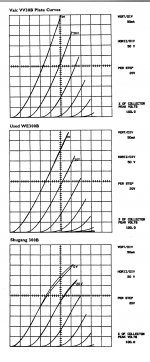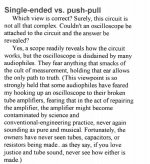Update on 30/6P15P-EV amp
I have been using this amp for a few months now. It has a clarity and realism that is better than the other amps in my stable. I haven’t used it as a mid and treble amp in my two ways yet, and have used it mostly with a pair if La Scalas. The only issues are that it will not go very loud full range, and that it has limited bass. I will try a battery based filament for the 30 tubes next, as that will greatly reduce complexity, and I would like to try building an amp that uses the two tubes as a driver for a large single ended triode. I am thinking about an amp using 30 - 6P15P-EV - 5998 with both triodes in parallel per channel. This should give me 7-8 watts per channel. What do you think of this idea?
I have been using this amp for a few months now. It has a clarity and realism that is better than the other amps in my stable. I haven’t used it as a mid and treble amp in my two ways yet, and have used it mostly with a pair if La Scalas. The only issues are that it will not go very loud full range, and that it has limited bass. I will try a battery based filament for the 30 tubes next, as that will greatly reduce complexity, and I would like to try building an amp that uses the two tubes as a driver for a large single ended triode. I am thinking about an amp using 30 - 6P15P-EV - 5998 with both triodes in parallel per channel. This should give me 7-8 watts per channel. What do you think of this idea?
Yes it is doable, but I think sonically a two stage 300b will be better.
Do you have a 300B amplifier & a similar 5998 amplifier on which to base this opinion? Will the same result be possible with other speakers & listening space? I'm curious how you are able to arrive at these conclusions.🙂
Do you have a 300B amplifier & a similar 5998 amplifier on which to base this opinion? Will the same result be possible with other speakers & listening space? I'm curious how you are able to arrive at these conclusions.🙂
I wrote 'I think...'
Yes I have a superb 2 stage 300b SE for daily use which is driven by a para-feed dht pre.
Also many years earlier I built parallel 6as7 SE.
Regards
Yes I have a superb 2 stage 300b SE for daily use which is driven by a para-feed dht pre.
Also many years earlier I built parallel 6as7 SE.
Regards
Sounds interesting. Please post the schematics for your 300B & 6AS7 SE Amplifiers. Are they your own design?🙂
Let tizman decide first what he wants to build.
What has that got to do with your schematics?
Most of those on DIY have their equipment well documented.
I don't recall ever seeing any schematic from you.
Do you have some photos shewing the top & underside open,
perhaps it will be possible to get an idea of the circuit from that.🙂
What has that got to do with your schematics?
Most of those on DIY have their equipment well documented.
I don't recall ever seeing any schematic from you.
Do you have some photos shewing the top & underside open,
perhaps it will be possible to get an idea of the circuit from that.🙂
I just took a quick look at the data sheet for the 5998. First thing that struck me was that the heater draws 2.4A! And if all you can get is ~7 or 8 wpc it seems to me there might be other tubes that could produce similar power output, using less heater current and might not require a separate input and driver stage to drive.I have been using this amp for a few months now. It has a clarity and realism that is better than the other amps in my stable. I haven’t used it as a mid and treble amp in my two ways yet, and have used it mostly with a pair if La Scalas. The only issues are that it will not go very loud full range, and that it has limited bass. I will try a battery based filament for the 30 tubes next, as that will greatly reduce complexity, and I would like to try building an amp that uses the two tubes as a driver for a large single ended triode. I am thinking about an amp using 30 - 6P15P-EV - 5998 with both triodes in parallel per channel. This should give me 7-8 watts per channel. What do you think of this idea?
I suspect some of the clarity you're getting with your current setup is because it only has 2 stages. Although my project using the 26 with 6N6G outputs is technically 3 stages and I'm also enjoying a lot of clarity and realism. Maybe that's because it has 2 stages in one bottle and they are directly connected? I don't know, but I like the results.
Sure, the 300B comes to mind when anyone says 8 wpc. But even the cheaper versions of the tube are not cheap, and then if you start wondering if a more expensive version would sound better and you decide to start tube rolling, well . . . $$$$$! But if your budget is not an issue, that would normally be the way to go. Of course, then you have to decide which of the hundreds of designs to use which leads to rolling not only tube brands but different schematics. A very deep rabbit hole indeed.
One tube that I mentioned earlier is the 7591 / 7868. You might be able to drive it with only the 30 or something similar. The heater only draws .8 A. Power output for a single tube is 11w in pentode. They are also in current production and not particularly expensive, if that matters to you. I'd probably try some type of local or Schade FB scheme.
Or, if you're only considering a triode and need ~8 wpc, you might consider using the 6N6G in PSE. Easy to drive and they have the same heater requirements as the 7591.
I'm sure there are others too but that's what comes to mind if easy to drive and modest heater requirements are considered important. If they're not, Thomas Mayer raves about the triode strapped 6CB5A as an 8 wpc alternative to the 300B. Of course his builds are so over the top that using inexpensive tubes doesn't make much difference.
VinylSavor: 6CB5A
Thomas Mayer raves about the triode strapped 6CB5A as an 8 wpc alternative to the 300B. Of course his builds are so over the top that using inexpensive tubes doesn't make much difference.
VinylSavor: 6CB5A
I'm a big fan of the EL38, but that and the 6CB5A have the anode connected to a top cap. Which means that the amplifier is a safety hazard unless the output tubes are in a cage of some kind. I'm reluctant to use any tube with an anode top cap for that reason. I'd just as soon put £140 on the table and get a pair of 300b and run them fairly cool so they'd last for years.
Real Performance Measurement Data on the Bench
Phoo! On all the straw men populating DIY! Lots of talk about their marvelous amps. But seldom seen is any measurement data to back up their claims. So here are some real measurements on a real PP 5998 Amp in hardware so all can see how it performs. No NFB & the 5998 is run inside its dissipation limits. Why don't we see more of this for all those marvelous amplifiers out there?😀
Its a sure thing that none of you have ever worked in a research lab. Where the application of Cooke's Variable Constant to the Measurement Data is frowned upon.😱
Phoo! On all the straw men populating DIY! Lots of talk about their marvelous amps. But seldom seen is any measurement data to back up their claims. So here are some real measurements on a real PP 5998 Amp in hardware so all can see how it performs. No NFB & the 5998 is run inside its dissipation limits. Why don't we see more of this for all those marvelous amplifiers out there?😀
Its a sure thing that none of you have ever worked in a research lab. Where the application of Cooke's Variable Constant to the Measurement Data is frowned upon.😱
Attachments
-
 Betty Crocker 5998 PP Version on the Bench.jpg127.8 KB · Views: 184
Betty Crocker 5998 PP Version on the Bench.jpg127.8 KB · Views: 184 -
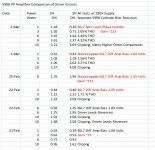 5998 PP Amplifier Comparison of Driver Circuits.jpg135.8 KB · Views: 178
5998 PP Amplifier Comparison of Driver Circuits.jpg135.8 KB · Views: 178 -
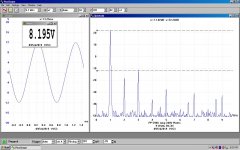 PP 5998 Amp 9 Watts.JPG125.6 KB · Views: 175
PP 5998 Amp 9 Watts.JPG125.6 KB · Views: 175 -
 PP 5998 Amp 3 Watt IMD 80 Hz & 5 KHz.JPG130.1 KB · Views: 173
PP 5998 Amp 3 Watt IMD 80 Hz & 5 KHz.JPG130.1 KB · Views: 173 -
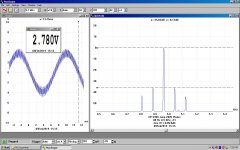 PP 5998 Amp One Watt IMD 80 Hz & 5 KHz.JPG127.9 KB · Views: 170
PP 5998 Amp One Watt IMD 80 Hz & 5 KHz.JPG127.9 KB · Views: 170
The 6N6G is a poor starting point for audio
Or, if you're only considering a triode and need ~8 wpc, you might consider using the 6N6G in PSE. Easy to drive and they have the same heater requirements as the 7591.
The plate characteristic of the composite tube is essentially the same as a pentode. So without NFB there is almost no damping & the D% characteristics are the same as a pentode. The 6N6G never caught on in the market, it offered nothing new. Beyond the quirky design. So better keep looking.
Period.😱
Or, if you're only considering a triode and need ~8 wpc, you might consider using the 6N6G in PSE. Easy to drive and they have the same heater requirements as the 7591.
The plate characteristic of the composite tube is essentially the same as a pentode. So without NFB there is almost no damping & the D% characteristics are the same as a pentode. The 6N6G never caught on in the market, it offered nothing new. Beyond the quirky design. So better keep looking.
Period.😱
Attachments
I just took a quick look at the data sheet for the 5998. First thing that struck me was that the heater draws 2.4A! And if all you can get is ~7 or 8 wpc it seems to me there might be other tubes that could produce similar power output, using less heater current and might not require a separate input and driver stage to drive.
I suspect some of the clarity you're getting with your current setup is because it only has 2 stages. Although my project using the 26 with 6N6G outputs is technically 3 stages and I'm also enjoying a lot of clarity and realism. Maybe that's because it has 2 stages in one bottle and they are directly connected? I don't know, but I like the results.
Sure, the 300B comes to mind when anyone says 8 wpc. But even the cheaper versions of the tube are not cheap, and then if you start wondering if a more expensive version would sound better and you decide to start tube rolling, well . . . $$$$$! But if your budget is not an issue, that would normally be the way to go. Of course, then you have to decide which of the hundreds of designs to use which leads to rolling not only tube brands but different schematics. A very deep rabbit hole indeed.
One tube that I mentioned earlier is the 7591 / 7868. You might be able to drive it with only the 30 or something similar. The heater only draws .8 A. Power output for a single tube is 11w in pentode. They are also in current production and not particularly expensive, if that matters to you. I'd probably try some type of local or Schade FB scheme.
Or, if you're only considering a triode and need ~8 wpc, you might consider using the 6N6G in PSE. Easy to drive and they have the same heater requirements as the 7591.
I'm sure there are others too but that's what comes to mind if easy to drive and modest heater requirements are considered important. If they're not, Thomas Mayer raves about the triode strapped 6CB5A as an 8 wpc alternative to the 300B. Of course his builds are so over the top that using inexpensive tubes doesn't make much difference.
VinylSavor: 6CB5A
FlaCharlie: 2.4 amps is a lot, but it is for the two triodes in a 5998. So 1.2 amps per triode. This is not that much more than most big power tubes that contain a single element. Also, I have 14 5998s at hand.
Perhaps it is the two stages that is what is providing the clarity and realism, but I do have a number of two stage amps that don’t have these qualities to the same degree. I could be wrong, but I think it’s the 30. The 6P15P-EV run hot may also be a contributing factor, but I have similar output stupa with different driver tubes, and they don’t have the same qualities.
As it happens, I bought 4 DIY amplifiers at an auction a while back that use 7868 tubes, as well as a few spares, so I may try that with a 30 driver.
I read the Mayer article about the 6CB5A a couple of years ago and ordered a bunch of them. I will need to check the amplification factor. It would be great if it could work as a two stage, but I could try it as a three as I want to do with the 5998.
I will need to check the amplification factor
It is 3.8, a good place to be for a triode amp. But will need a strong driver.
The top cap is a killer for me, so 6CB5 falls off the bottom of my list.🙂
The 7591 / 7868 have an amplification factor of 16.8, which is close to a 6BQ5s 19. This should work well. I’ll need to check the power out in triode.
Its a sure thing that none of you have ever worked in a research lab.
-I have not worked in a research lab. Many of us have not. Still we do diy and encourage each other. It is meant for personal enjoyment, nothing else.
Regards
-I have not worked in a research lab. Many of us have not. Still we do diy and encourage each other. It is meant for personal enjoyment, nothing else.
Regards
-I have not worked in a research lab. Many of us have not. Still we do diy and encourage each other. It is meant for personal enjoyment, nothing else. Regards
Indeed. Many of us are self taught, not qualified EEs even. And many of the "marvellous" untested amplifiers may in fact be very good sounding. Many of us have been building and listening to amps for 10, 20, 30 years. That's a lot of time in development and refining circuits. It's quite possible to develop good amps by listening to them. Nothing wrong with measurement, of course. If you have the equipment and the training then data and results really help the community move forward.
All I asked Minhaj for was a schematic of the 300B SE amplifier he had referred to. He was either unable or unwilling to share that. The schematic in question is probably that of a SE Asia knockoff amp builder, common in that part of the World.
Makes me wonder in Minhaj has ever built a toob amp or anything else at all. A few months back Minhaj had posted advice on PS filtering. The advice given was one of the most bazaar I’d ever seen. Minhaj should not be advising others given his very limited knowledge of the craft.
And all 300Bs are not equal. See the attached plate traces of some 300Bs run about 20 yrs ago. The Shugang sample shews sagging & open trace. That will give your expensive SE amp an interesting personality. Some may prefer that. The situation is probably not much different today.
And John Broskies remarks with regard to AudioPhools regard for test equipment.🙂
Makes me wonder in Minhaj has ever built a toob amp or anything else at all. A few months back Minhaj had posted advice on PS filtering. The advice given was one of the most bazaar I’d ever seen. Minhaj should not be advising others given his very limited knowledge of the craft.
And all 300Bs are not equal. See the attached plate traces of some 300Bs run about 20 yrs ago. The Shugang sample shews sagging & open trace. That will give your expensive SE amp an interesting personality. Some may prefer that. The situation is probably not much different today.
And John Broskies remarks with regard to AudioPhools regard for test equipment.🙂
Attachments
The data you posted is the highly abridged version. Here's the data for the 6B5 which was the original version of the 6N6G. This is probably the most detailed data sheet I've ever seen, so you might enjoy it.The 6N6G is a poor starting point for audio
The plate characteristic of the composite tube is essentially the same as a pentode. So without NFB there is almost no damping & the D% characteristics are the same as a pentode. The 6N6G never caught on in the market, it offered nothing new. Beyond the quirky design. So better keep looking.
Period.😱
I've been unable to determine the name of the designer(s) but they did work in a research lab. 😉
The technical aspects are over my head, I just use the tube. It is quirky and I doubt many people here have listened to it. Have you?
As for the suitability of the 6N6G, all I can do is go by what my ears tell me. As I've said, I seem to be getting the same levels of realism and detail with my 26 - 6N6G SET that tizman has experienced with his 30 - 6P15P-EV combo.
I only have one other SET that uses DH tubes to compare it to, which is a 45 SET I built some time ago. It's the Bugle which was designed by Gordon Rankin and published as a DIY project in Sound Practices back in 1997.
Many designs published in the '90s faded quickly into obscurity. This one has not. It's a highly regarded design which is still recommended today as one of the best for those who want to build a 45 SET. I suspect hundreds (possibly thousands?) have been built since it was introduced. Perhaps there are better designs out there, but it's an excellent amp with a long-established track record. So if "catching on" is the measure of a good design, it seems to qualify.
Yet, somehow, my 26 - 6N6G "inverted" SET sounds better. And not just by a bit. More realistic and detailed. Much better soundstage. When playing thumpy, bass heavy tracks the bass is solid and well controlled. Not a hint of flabbiness. And it sounded better with all of the various types of DHT input tubes I tried, including the 30 and probably 8 or 10 others.
So, if the 6N6G is as much of a turd as has been suggested, the amp's superior sonics must be the result of my design brilliance.
Comma,🙄
Attachments
Last edited:
I understand. You've got a slew of 30s and 5998s and want to put them to use.FlaCharlie: 2.4 amps is a lot, but it is for the two triodes in a 5998. So 1.2 amps per triode. This is not that much more than most big power tubes that contain a single element. Also, I have 14 5998s at hand.
Perhaps it is the two stages that is what is providing the clarity and realism, but I do have a number of two stage amps that don’t have these qualities to the same degree. I could be wrong, but I think it’s the 30. The 6P15P-EV run hot may also be a contributing factor, but I have similar output stupa with different driver tubes, and they don’t have the same qualities.
As it happens, I bought 4 DIY amplifiers at an auction a while back that use 7868 tubes, as well as a few spares, so I may try that with a 30 driver.
I read the Mayer article about the 6CB5A a couple of years ago and ordered a bunch of them. I will need to check the amplification factor. It would be great if it could work as a two stage, but I could try it as a three as I want to do with the 5998.
I'm unfamiliar with the 5998 but if it needs more drive I can certainly see why you'd want to, in effect, just add them on to your existing amp. Seems to be a valid strategy and hopefully it will live up to your expectations.
I grabbed some 6CB5As a while back too and did breadboard an amp with them. I'm not sure if I drew up a schematic, though. I'll have to look. As I recall, it did sound good but I didn't build it. Top caps don't concern me as long as a ceramic insulator is used and voltages aren't really high. No high voltage transmitting tube amps for me, regardless of whether or not they have a top cap.
I've never heard of anyone using the 7591 / 7868 in triode so I have no idea how much power you might get. If it's similar to other tubes, maybe a bit less than half? I do have several vintage Sherwood PP integrated amps that use them, though, and they all sound great.
As for the quality of the sound you're getting from your existing amp, I can only speculate but I suspect the basic topology plays a big part - a DHT input tube driving an indirectly heated output that's easy to drive. So perhaps the sonics have more to do with the input tube than the output, at least in this type of topology.
There don't seem to be any DH output tubes that are as easy to drive, but if there are, that might sound even better.
If you try adding an output tube that's harder to drive to your existing amp, it will be interesting to see how the overall sound is affected.
Last edited:
I understand. You've got a slew of 30s and 5998s and want to put them to use.
I'm unfamiliar with the 5998 but if it needs more drive I can certainly see why you'd want to, in effect, just add them on to your existing amp. Seems to be a valid strategy and hopefully it will live up to your expectations.
I grabbed some 6CB5As a while back too and did breadboard an amp with them. I'm not sure if I drew up a schematic, though. I'll have to look. As I recall, it did sound good but I didn't build it. Top caps don't concern me as long as a ceramic insulator is used and voltages aren't really high. No high voltage transmitting tube amps for me, regardless of whether or not they have a top cap.
I've never heard of anyone using the 7591 / 7868 in triode so I have no idea how much power you might get. If it's similar to other tubes, maybe a bit less than half? I do have several vintage Sherwood PP integrated amps that use them, though, and they all sound great.
As for the quality of the sound you're getting from your existing amp, I can only speculate but I suspect the basic topology plays a big part - a DHT input tube driving an indirectly heated output that's easy to drive. So perhaps the sonics have more to do with the input tube than the output, at least in this type of topology.
There don't seem to be any DH output tubes that are as easy to drive, but if there are, that might sound even better.
If you try adding an output tube that's harder to drive to your existing amp, it will be interesting to see how the overall sound is affected.
My amp is set up for 6V6 or 6P14P-EV. The 6V6’s amplification factor is too low to use just it and the 30 tube. I see two possible paths forward for the next amp with a 30 input tube. Either I try a three stage with a difficult to drive low AF final, or I try another two stage with an easier to drive higher AF final. The front end of the new amp will use battery filaments on the 30 for starters. I hope that sounds good. Could I use filament bias with batteries on the 30, or is that not workable?
- Home
- Amplifiers
- Tubes / Valves
- DHT driver for triode wired SE EL84, 6V6 or EL34
